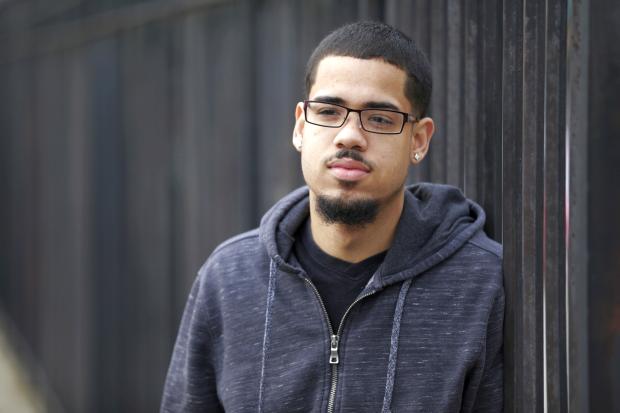New York, North Carolina: When should teen be tried as adult?

In this photo, taken Feb. 22, 2017, Luis Padilla poses for a picture near his home in New York. Padilla was arrested at 16 and sent to Rikers Island. New York and North Carolina are the last two states that still prosecute all 16- and 17-year-olds as adults in criminal court and house many in adult facilities. But changes may be coming. (Photo by SETH WENIG/AP)
ALBANY, New York — Luis Padilla remembers the terror he felt as a 16-year-old arrested on a robbery charge and locked up with adults in New York City’s notorious Rikers Island jail. At one point, he pretended to be suicidal so he could be placed in the relative safety of a locked observation cell.
“Even now if I see a Rikers bus, I start to get jumpy and scared,” said Padilla, now 23, who was released after two months and now works nights at a warehouse in Harlem.
New York and North Carolina are the last two states that still prosecute all 16- and 17-year-olds as adults in criminal court and house many in adult facilities. But changes may be coming.
Both states are considering bills to raise the age of criminal responsibility to 18, with backers saying the measures could save millions of dollars by providing rehabilitative services young people need to keep from reoffending. The proposal also would allow young offenders to avoid adult records that can affect their opportunities for housing, loans and higher education.
“You can’t go to a tanning booth without your parents’ permission if you’re not 18,” said Paige Pierce, chief executive of child advocacy group Families Together in New York State. “Voting, joining the military, buying cigarettes, these are regulated because they’re minors. Why would we, in this one area, consider 16- and 17-year-olds as adults?”
Article continues after this advertisementChild advocates say the research is clear: The brain of a 16- or 17-year-old is not fully developed, and the adult criminal system does not include parental or community involvement for mental health, public education and social services that younger offenders need to create a life outside of the criminal system.
Article continues after this advertisementThe Centers for Disease Control and Prevention found that youths in the adult criminal justice system are 34 percent more likely to be arrested again than those in the juvenile system, costing states millions more.
In North Carolina, which places about 30,000 16- and 17-year-olds a year into the adult system, the lure of an estimated $52 million in such savings is pushing the GOP-controlled Legislature closer than ever to raising the age this year, said Democratic Rep. Duane Hall, sponsor of the proposal.
In New York, which has at least 28,000 16- and 17-year-olds treated as adults every year, a measure to raise the age has so far been gridlocked in technical and political squabbles.
Like it has in years past, the Assembly’s Democratic majority has already voted to move all 16- and 17-year-olds, except for violent felons, out of criminal court by next year. The vote that matters, however, is in the divided Senate where most proposals ride on a rogue coalition of eight Democrats who change the chamber’s majority by voting with Republicans.
The group’s leader, Sen. Jeff Klein, has called the issue a key priority and has promised to negotiate with Republicans and district attorneys who have opposed the measure before.
Prosecutors say the sealing of records in family court would prevent them from understanding whether the teenager is a first-time or repeat offender when making plea deals. The attorneys also say an influx of cases could burden smaller family courts upstate.
New York already has some systems in place to treat youth differently than adults. A judge can award a youthful offender status alongside a punishment that would prevent a teenager from carrying a criminal conviction.
Senate Republican leader John Flanagan said the issue has prompted some strong feelings among Republicans and is complicated. He said a compromise will be a significant part of the final spending agreement with Democratic Gov. Andrew Cuomo, who included raising the age of criminal responsibility to 18 in his $152 billion dollar budget.
Cuomo’s plan would stretch the age increase out until 2020 and exclude a wider array of crimes. Democrats say they are worried compromising will result in weak changes to a broken system.
Padilla has seen it from both sides. He was 13 and in the juvenile justice system for burglary before his arrest at age 16 and his time in Rikers. He said if it hadn’t been for staff at the juvenile center that taught him music, took him camping on weekends and told him he could be different, he never would have left or gotten an education.
“I probably would have been dead or in jail,” Padilla said. “I would have stayed in the neighborhood and joined gangs instead of understanding there’s resources out there.” –Anna Gronewold